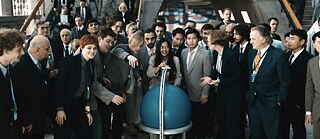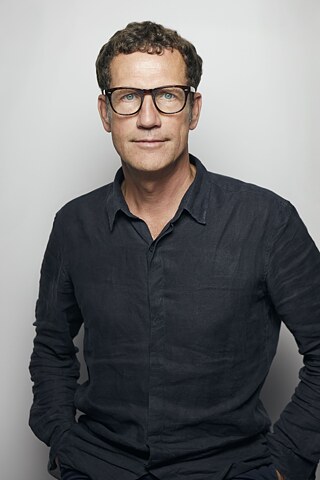The Billion Dollar Code
Art from the future

The acclaimed Netflix series “The Billion Dollar Code” is based on the life of the artist Joachim Sauter. But who was this man who challenged Google?
By Niklas Maak
There are some works of art that look like they come from the depths of the past. Objects can be seen in galleries that are more reminiscent of hand axes or cave paintings. And occasionally, but much more rarely, one might spot artworks that look as if they originated in the future. That’s the kind of work the “Zerseher” (Iconoclast) is. One stands in front of a painting – or to be more precise in front of a screen that is displaying Giovanni Francesco Caroto’s “Portrait of a Child with a Drawing”. As one’s eyes wander across the image on the screen, something disconcerting happens: those parts of the painting that one is looking at disappear; they are erased from the painting as if by an invisible hand. If one focuses one’s attention on the eyes of the child in the picture, they are suddenly no longer visible. It is as if one’s own eyes were devouring the portrait.
The explanation is a camera that tracks the viewer’s eyes. A PC uses it to analyze the position of the eyes, and an algorithm causes the image to blur at the precise spot one is scrutinizing. If this work were to be shown in a gallery today, it would be lauded as a reaction to the ubiquitous cameras that watch our every move and everything we do, and that use algorithms to analyze the findings: the CCTV cameras in supermarkets and the cameras fitted to the latest cars that monitor the driver’s eyes so that an algorithm can determine whether the driver might be tired.
The “Zerseher” describes with a fair degree of accuracy the situation into which digital corporations have guided the world in the year 2021 – yet this artwork is by no means recent; it was created in 1992. It was one of the first works to use a computer for interactive art and, long before digital surveillance capitalism emerged, made its consequences only too clear. And the fact that it is not mentioned nowadays in the same breath as Nam June Paik‘s “TV Buddha” is partly because Joachim Sauter, the author of this work, was not interested in a conventional career in the art world. All the same, there are many parallels between the “Zerseher” and the TV Buddha: in the latter, a Buddha statue is sitting in front of a television while being filmed by a video camera so that it looks as if the Buddha is watching its own image on a continuous loop. Paik presented his work, which was celebrated as symbolic of the media era, in a gallery in 1974 – while Sauter exhibited his at the Ars Electronica in 1992.
33 years old at the time, he was one of the youngest art professors in Germany and co-founder of an agency whose position between art, research and design in Germany, a country with very distinctly compartmentalized beliefs, nobody quite understood: Art+Com had been established by artists, scientists and hackers in Berlin in 1988, mainly at Sauter’s instigation, had close ties to the Chaos Computer Club, and was keen to explore the opportunities that computers might offer as a medium of communication, what could be achieved with virtual reality, and how interfaces could be used to rethink the authoritarian relationship between passive observer and active artist.

In real life, Sauter had presented Terravision to the computer manufacturer SGI; its chief development engineer Michael T. Jones founded his own business – and suddenly unveiled the “Earth Viewer”, which was renamed “Google Earth” following the sale of the company to Google.
Around 90 people work at Art+Com nowadays; the firm produces media installations that Sauter’s artist colleague and friend Christian Möller, who teaches in Los Angeles, celebrates as “masterpieces that are unmatched in terms of their design”. These are kinetic sculptures that react to the movements of the audience. One work is composed of over a thousand metal balls hanging on thin threads; centrally controlled, they can adopt any shape – rather like a shoal of fish. What Sauter wanted to do was reconnect digitality with actual effects in the physical realm, with physical experiences.
He was always ten years too early.
Werner Aisslinger about Joachim Sauter
Not only did Sauter create one of the most important interactive works at a very early stage, he was also one of the most extraordinary university teachers of his generation. Anyone who had the good fortune to experience him will remember the kind and warm-hearted way in which he devoted himself to his students. The fact that he did not work doggedly to pursue a career in the world of collectors and galleries and did not develop a signature style that would sell easily makes him no less likeable nor less important. His research influenced all kinds of different fields. “Joachim was one of the world’s leading pioneers of the connection between the physical and virtual spheres”, says the architect Wolfram Putz. “We were fascinated by his ability to combine and fuse the two”. As the teacher of the legendary “digital class”, Sauter influenced many students. The designer Werner Aisslinger also studied under him.“He was always ten years too early”, he says. “What he was doing would not become reality until the day after tomorrow. But he was never an egomaniac who wanted to pursue an artistic career above all else. Others with his abilities would have become at least another Ai Weiwei.” For once the forbidden and jaded term “visionary” would actually be apt to describe Joachim Sauter and his works, which address not only the strategic clouding of our vision by digital awareness corporations, but also the potential that digitization would offer if it were freed from the clutches of Silicon Valley.
Joachim Sauter died schockingly quickly of cancer last summer. His art remains – and battles far more successfully against the manipulative world of Google than any lawyer ever could.